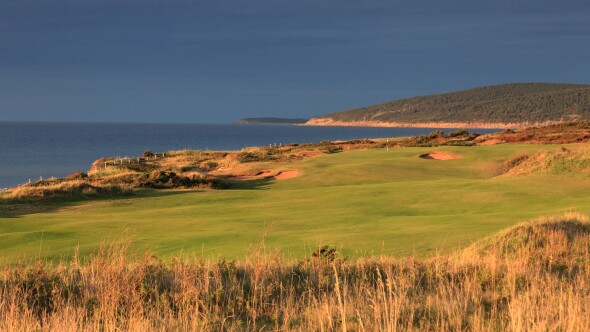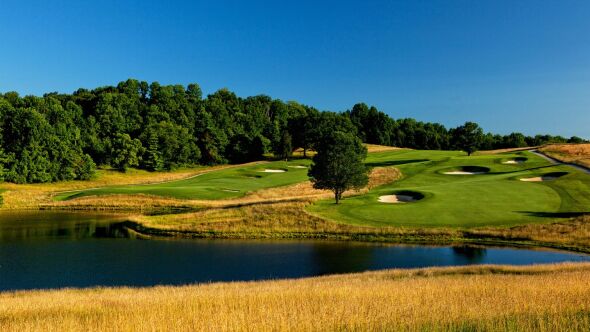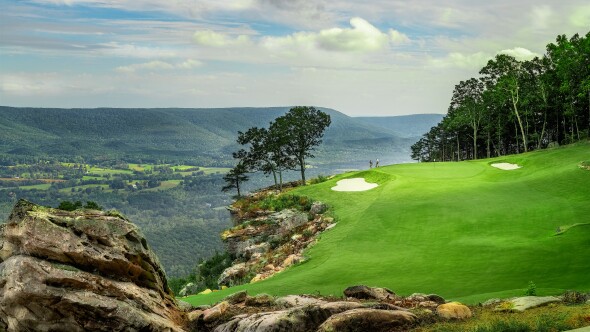NEKOOSA, Wisc. — This place is big. Like, ginormously expansive on a scale that’s playfully indulgent and at times overwhelming to the golf senses.
Architect David McLay Kidd's latest design is Mammoth Dunes, the follow-up course to Sand Valley at the resort of that name in Central Wisconsin. Owner/developer Mike Keiser, who founded Bandon Dunes on the Oregon coast and was co-founder of Cabot Links in Nova Scotia, is at it again turning remote, proverbially “middle-of-nowhere” sites into a ”must-see” destination.
Keiser’s previous destination successes involved the allure of shoreline and the beauty of golf along its edge. This time he has gone deep into the American heartland, on a 1,600-acre site of billowing, massive sand dunes. The land here was formed in the aftermath of glaciation during the Ice Age 20,000 years ago. As the ice melted it formed a massive lake, which eventually drained out to leave vast deposits of sand. Keiser’s vision has been to utilize this ideal medium for links-inspired golf while reclaiming much of the native habitat and plant life that had been displaced when the land had been converted into a pine tree farm.
The resort’s first course, Sand Valley, by Bill Coore & Ben Crenshaw, opened two years ago on a parcel that had been heavily planted over with row upon row of those pines – since removed to allow the native vegetation to grow back. Kidd’s adjoining parcel had remained largely unaffected by that commercial pine tree operation, mainly because the underlying ground had more intense elevations and was divided by a long circular ridge. Traversing that ridge was a major problem in settling upon a walkable routing.
Kidd, a native Scotsman, made his name 20 years ago with the opening of the first course at Bandon Dunes. For someone who takes his design cues from linksland, he can be surprisingly technical in his engineering skills. That came in handy in creating the holes at Mammoth Dunes. It took what he calls a “curious combination of science and feel to make this routing work.” He and his design time walked the site extensively. They also took a detailed topographic map of the land, overlayed it on AutoCAD and tinkered with the grades through a three-dimensional digital program that enabled them to test if the grades would work for intimately connected golf.
The holes on a standard golf course require about 125 acres of buildable uplands – minus ponds, wetlands and slopes exceeding seven percent grade for full shots. Mammoth Dunes fills up 500 acres – much of it exposed, randomly chunked-out sand that that flanks the holes and proves an impressionist frame for the 120 acres of maintained, playable turfgrass. Some other numbers to provide a sense of scale: your average course has 25-30 acres of fairway. Shinnecock Hills is expansive with 43. Mammoth Dunes has 85 acres of fairway – in some landing areas 100 yards across. Your average U.S. green is 5,000-6,000 square feet. At Mammoth Dunes, they are 10,000 square feet. The place is big.
Anything else would not have worked or would have looked like a Spinal Tap version of Stonehenge. And using long gradients rather than sharp transitions was also the only way to make the site walkable. The key was getting over and across that ridge line without requiring an elevator or golf cart. The course starts in the interior of the dunes line, then transitions over at the uphill, par-3 fourth hole, and then circumnavigates on the outside for nine holes before transitioning back at the par-3 13th hole.
It’s impossible not to be overwhelmed at the natural spectacle of this 130-yard, downhill hole – to a green sitting on a platform above a natural blowout. Like so much at Mammoth Dunes, the scale of the shot is disorienting because it’s hard to focus on the task at hand when there is so much going on in terms of massive landforms.

The 13th hole at Mammoth Dunes (Matt Ginella/Golf Advisor)
Golf on this scale is often criticized as being too generous and not demanding enough in terms of precision and shot making. That’s the knock on Kidd’s work at Gamble Sands in central Washington. Curiously, that course has proved wildly popular among fee-paying golfers.
At Mammoth Dunes, the width of the fairways and the size of the greens can be a relief to golfers who are trying to get around without getting beaten up. But that overlooks a crucial difference that Kidd has built into this golf course. If you don’t worry about your score and just want to get around, that scale works to your advantage. But at the same time, at every turn, the slopes, angles and ground features have a purpose that has strategic value if you are trying to make par (or better) and care about your score.
That principle gets established early for anyone who looks carefully. At the par-4 second hole, a 410-yard, sweeping dogleg left from the back and 360 yards from the middle tees, the landing area is massive. But a diagonal cant to an intervening waste area creates a strategic choice. The golfer could play a longer drive right that challenges sand and leaves a much better approach angle into the green. Left off the tee is safe but leaves an obstructed line in. If the hole is located front or right, the strategic choice is reduced. But when the hole is cut back-left, the effect of the options is compounded and that seemingly safe shot left leaves you with no way to get it close on your approach.
At the next tee, a double-dogleg par 5 of 518 yards from the back and 468 yards from the middle, the smart, average play is way right off the tee, then left on the second shot to leave a clear third in. But the bold player has a riskier alternative to play it tight down the left off the tee to bring the green within reach on the second shot.
Kidd’s achievement at Mammoth Dunes is to make those alternatives evident throughout. And the green contours are sufficient to make position on the big, bentgrass surfaces consequential. High handicappers are happy to reach any part of a green and don’t stress about three-putting. But good players pay a price if on the wrong side while putting.
Mammoth Dunes, a par 73, provides plenty of room, from the 6,988-yard Black tees down to the 4,055-yard Royal Blue markers. The fescue fairways will play firm and fast and provide plenty of roll out that enhances the feel of the ground. And there’s plenty of ambient wind to create uncertainly out here in these massive dunes.
The psychological effect of all of this is mesmerizing. Some will find the scale disorienting. I found it compelling.





























Great review.
“Curiously, that course has proved wildly popular among fee-paying golfers.”
Count me among those. Gamble Sands is a spectacular golf experience. I appreciate Kidd’s understanding of the average-skilled yet passionate golfer. We need more designers who bias towards enjoyment and experience over challenge and prestige. Can’t wait to get out to Mammoth.
Played Sand Valley last fall and only a select holes on Mammoth since the course was not open yet. Can't wait to get back to play both courses!!
The 13th looks like a copy of Mike Stranz's 4th hole at Tobacco Road in Sanford, NC. That;s a good tract to emulate, but they could at least acknowledge the inspiration for the hole's design.
Mammoth Dunes is simply magnificent I was there on Wednesday May 30th for a David Mclay Kidd event celebrating the opening of the course in fact Bradley Klein's team shot a 65 It's a Wonderful walk it is truly golf as as meant to be . When you go to San Valley Resort play the courses please don't forget the 17 hole par 3 sandbox.
Sounds like he read Dr Alastair McKenzie's book on golf course architecture! I am sure he has and has been fortunate enough to be given an appropriate site on which to show his skills. Cannot wait to get there.
Thanks for the update on mammoth Dunes Bradley. Heading up there this weekend to play all three courses. I'll provide you a high-handicapper update after!